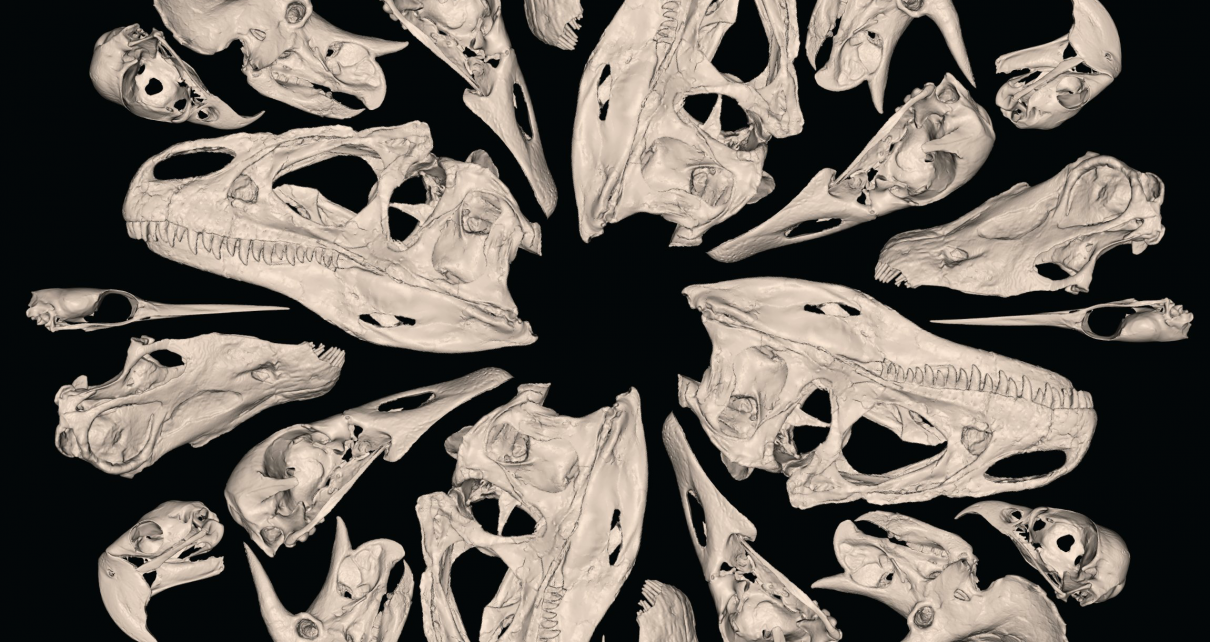This past May, when it finally sank in that I was going to be stuck at home for a very long time because of the pandemic, I took up a hobby that had never especially appealed to me before: birding. I cleaned my neglected bird feeder and filled it with seed, retrieved my binoculars from a gear bag in the basement and started having my morning coffee outside, slowly learning to identify species based on body size, feather colors, beak shape and song. At last count, I had logged 39 species from the confines of my suburban backyard. These hours spent observing birds—the goldfinches congregating at the feeder, the pileated woodpeckers drumming in the trees, the turkeys strutting across the lawn, the ruby-throated hummingbirds hovering above their favorite blooms, the red-shouldered hawks circling overhead—have given me a newfound appreciation for their diversity. And I’m seeing only a sliver of the actual richness of avian forms. With more than 10,000 species alive today, birds constitute the most diverse group of land vertebrates (backboned animals) on Earth. How did they come to be so spectacularly varied?
Scientists have tended to view modern bird diversity as the result of a burst of evolutionary activity that occurred after the mass extinction that wiped out the nonbird dinosaurs. (Birds are themselves dinosaurs, the only lineage to survive to the present day.) The idea was that after the dinosaur-killing asteroid crashed into Earth 66 million years ago, birds had the place largely to themselves. Free of competition from other dinosaurs (not to mention a whole bunch of other vertebrates that also perished, including the pterosaurs, those flying reptiles that had long ruled the skies), birds abruptly exploded into a multitude of forms to fill the many newly vacant ecological niches.
Now a new analysis has turned up intriguing evidence that their extraordinary diversity might not have originated that way. In a study of hundreds of bird and dinosaur skulls, Ryan Felice of University College London, Anjali Goswami of the Natural History Museum in London and their colleagues found that in the aftermath of the mass extinction event, the pace of birds’ evolution actually slowed way down, compared with that of their dinosaur predecessors, rather than accelerating as expected. The paper, published on August 18 in PLOS Biology, reveals the rate of evolution during the radiation of a major vertebrate group and hints at factors that may have played a key role determining its course.
“Birds have incredible diversity in the shape of their skulls,” Felice observes. Consider hawks versus hummingbirds, he says, or pigeons versus pelicans. “Did birds evolve their highly variable skulls by evolving more rapidly than their nonavian dinosaur ancestors?” Felice asks. That might seem like a narrow question, but “it gets toward an understanding of how diversity evolves,” he explains. “If a group of organisms is really diverse, do they achieve their diversity really quickly in an explosive burst? Or is it slow and steady?”
To investigate, the team carried out a detailed shape analysis of 391 well-preserved skulls from modern birds and extinct dinosaurs using high-resolution 3-D scans of the specimens and reconstructed their evolution. Typically skull-shape comparisons rest on the use of established landmarks—such as sutures and bumps—that all of the various species under evaluation share. But the larger the study group, the fewer the points of correspondence. As a result, investigations that focus on traditional landmarks lose much of the information about skull shape. “Our approach takes those landmarks and uses them as anchors for curves that connect up those landmarks and, in doing so, outline and delimit the individual bones of the skull,” Goswami says. “Our automated approach then takes a generic template of points and fits the exact same template to all of the specimens in our data set by using the landmarks and curves to identify the regions of interest. So you can get points distributed across the surface of a bone in a consistent way, regardless of whether the bones you are looking at look like the flat, bony structure under the beak of a duck or the tall, biting [snout] of a T. rex.”
What the researchers found was that dinosaurs evolved 1.5 to three times faster than birds in all regions of the skull. After the mass extinction event brought the Mesozoic era to a close and ushered in the Cenozoic era, birds diversified. But they did so far more slowly than their Mesozoic dinosaur forerunners. “Their rate of morphological change declines just as they are taking off as a radiation,” Goswami says.
Why the sudden deceleration? Goswami thinks it reflects a shift in priorities for skull function. Whereas dinosaur skulls have elaborate display and fighting structures and complex feeding mechanisms that require large areas for jaw-muscle attachment, bird skulls are mostly dedicated to housing and protecting the animals’ comparatively large brain, she explains.
Bird evolution experts who were not involved in the new research praised the team’s methodology and the vast number of species they included in their study. The finding that dinosaurs had a much faster rate of skull evolution than modern birds “might seem strange at first glance,” says Daniel Ksepka of the Bruce Museum in Greenwich, Conn. “After all, consider the wonderful variety of bill shapes in birds like spoonbills, flamingos and pelicans. That suggests a high rate of beak evolution.” But a closer look reveals that these distinctive bills are the exception rather than the rule, he adds. “There are plenty of groups where dozens of related species share a pretty similar skull shape, like warblers or parrots, suggesting relatively little skull evolution,” Ksepka says. In contrast, some groups of dinosaurs clearly had sky-high rates of skull evolution. Among the ceratopsians (Triceratops and its kin), for instance, “each species had a unique arrangement of horns and crests. And these seem to have evolved rapidly due to their value for attracting mates,” Ksepka notes. “So many dinosaurs had these elaborate skull ornaments, but they are very rare in birds (the cassowary is one awesome exception),” he adds. “It’s likely that feathers took over the display role, as we have plenty of modern birds with plain-shaped skulls but beautiful feathered head crests. Just look at your friendly backyard cardinals and blue jays.”
The discovery that bird skulls resulted from relatively low evolutionary rates “is essentially opposite from what we know of the rest of the skeleton,” observes Stephen Brusatte of the University of Edinburgh in Scotland, another outside expert. “Previous studies, including one of my projects, showed that bird skeletons evolved faster than nonbird skeletons. What this means, I think, is that the origin of birds was driven by rapid and remarkable changes to the skeleton: particularly turning the arms into wings for flight. The heads were less important in this transition, and they probably lagged behind the rest of the skeleton.” Early on in their evolution, birds seem to hit on a head design that worked for them, with such features as a beak, big eyes and and a large brain, he says. “Birds didn’t need to radically change any of these things in order to adapt to different niches.” Instead, Brusatte suggests, “after birds split off from other dinosaurs and went into the skies, they adapted to new niches by changing their body sizes, wing shapes and flying styles more than their heads.”
Such mosaic evolution, in which different parts of the body evolve at different rates, is known to have occurred in many organisms, including humans. Ksepka notes that the ceratopsians’ high rate of skull evolution contrasts starkly with barely discernable change in their limb bones. Meanwhile modern warblers, he says, exhibit very little change in skull shape but have evolved “a kaleidoscope of color patterns.”
But Goswami has a hunch that other parts of the bird skeleton may have also evolved on a relatively leisurely timetable. Nonbird dinosaurs transition between bipedal and quadrupedal body plans several times over the course of their evolution and do a lot of different things with their forelimbs, she points out—think of T. rex’s puny arms, compared with a titanosaur’s tree trunks. In contrast, once birds specialize for flight, they riff on that theme a lot over their evolutionary history but never really evolve completely new body plans—presumably because of the developmental or functional constraints of being a bird. “I expect that future studies with sampling as broad as ours will also start to find that birds are, quite frankly, not keeping up with the pace of evolution observed in the other dinosaurs,” Goswami says.
Of course, the birds are no less spectacular for that downturn. They survived fire and brimstone, conquered the skies and diversified into the dazzling array of feathered wonders that share the planet with us today. Slow and steady won the race.




